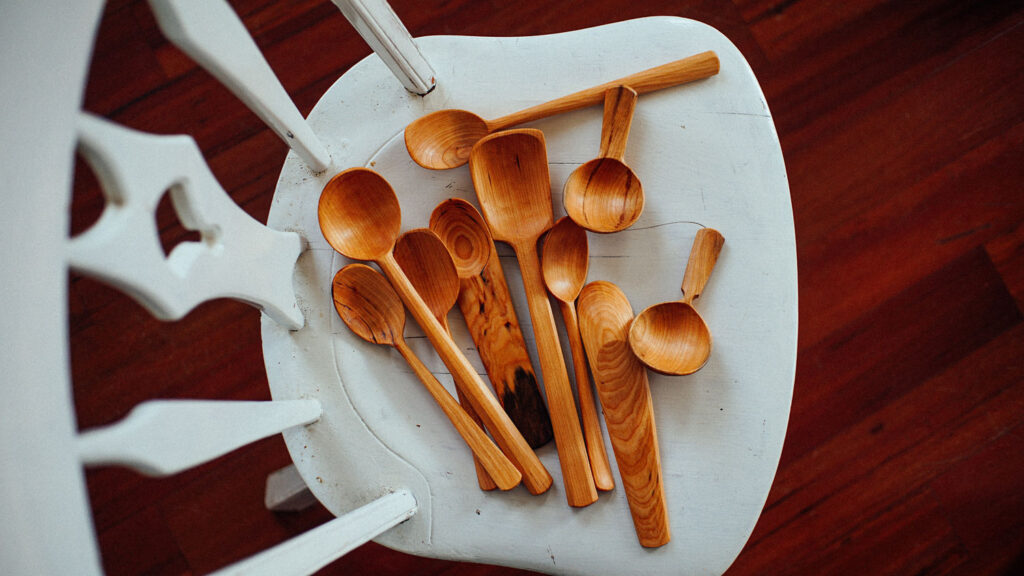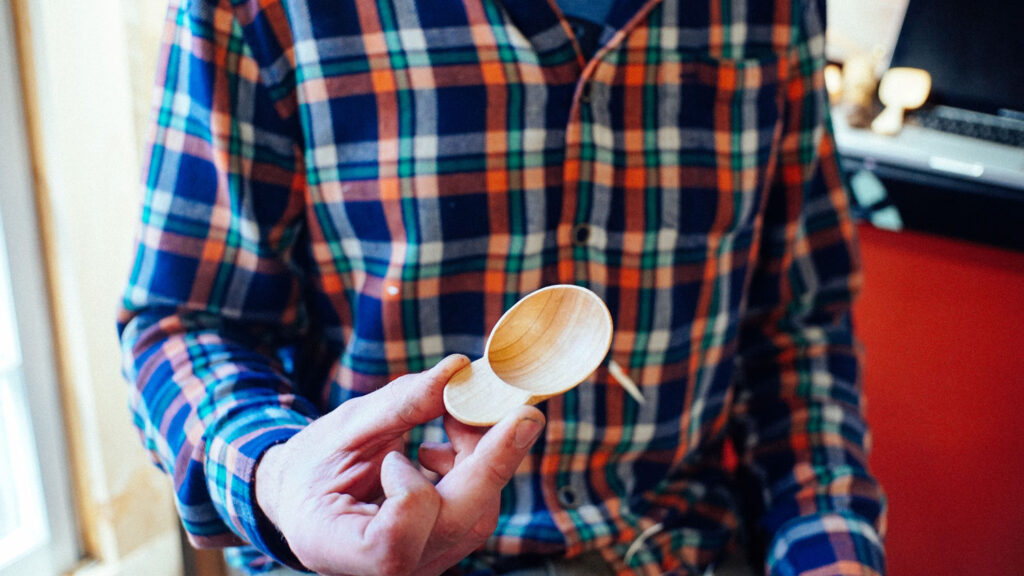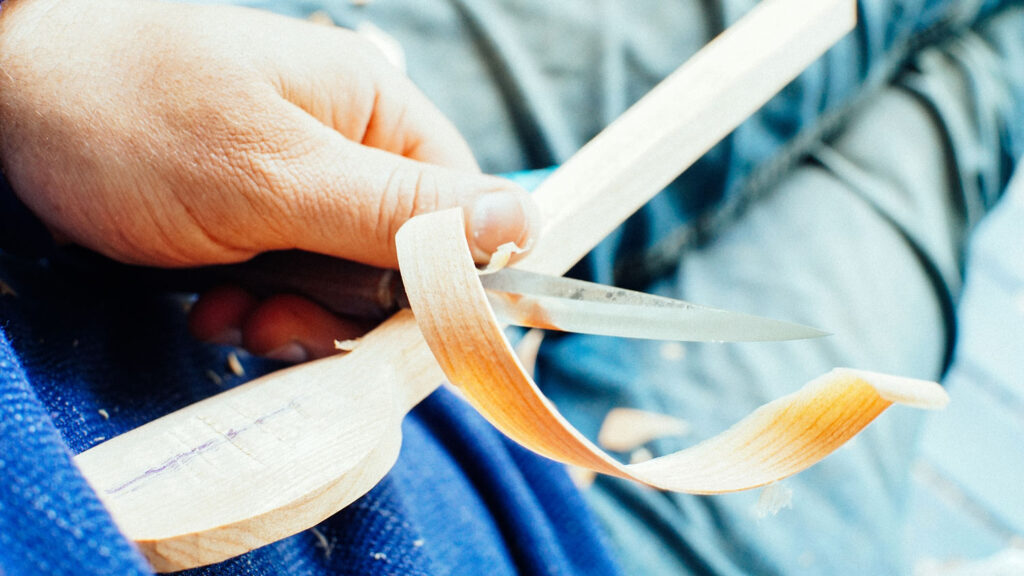When people ask me what I do, I don’t know what to say. The first problem is that I wear a lot of hats. I have a Christmas tree farm, a scientific editing business, and I carve wooden spoons.
That last one is particularly hard to take seriously. I can barely bring myself to say it, not because I think it’s silly, but because it is something that is almost a non-answer. And carving spoons for a living is just a part of what I do within that description; really I carve spoons, prepare rough spoons blanks for others to carve, and teach spoon carving.
Telling someone you’re a spoon carver is a bit like telling them you’re a lion tamer or a douser. People either have no idea what that actually entails or they jump to all sorts of romantic assumptions. The most common question they have is “You can do that for a living?”

That was the question I had myself when I first decided to pursue spoon carving as a way to earn a meaningful portion of my yearly income. I already had the tree farm and the editing business and a part time, seasonal job that I wanted to leave. I thought that it was reasonable to be able to replace the several thousand dollars I made from that job with income from carving spoons. I had been carving a small number of spoons each year and selling them at my Christmas tree farm, and I saw online examples of people who, at least in how they presented themselves, seemed to be making the kind of money I wanted to make. So I took the leap.
I left the job, and bought my first smart phone and joined Instagram. I started figuring out the labyrinth of social media, the patterns of posting and nuances of photography and caption and hashtag that were a foreign language to me. I thought I was good enough to show up and make myself known to the world and that the world would recognize my worth and it would all work out.
I came to realize, that first year, that I wasn’t as good at my craft as I thought I was. I also vastly underestimated the time it would take to build up a community that would support what I did. Partly this was my own fault. In the grand awareness of everyone else doing what I do in the world, I made the fatal error of thinking that my prices should match those I saw, that if I saw someone who seemed to be successful charging a certain amount for their work, then that was proof that I should charge a similar amount, even if it seemed too high for my taste. I should have listened to my heart more.
What I briefly forgot (and something I had learned as a vegetable farmer, and then with my tree farm and editing business) is that price is just a common ground between you and a buyer, one that should go up or down based not on what others are doing, but on your own opinions, your own needs, your own availability. Price is just a tool, and the trajectory of price changes over time is just as important (if not more so) than the actual price at a given moment.
I faltered and almost failed that first year, and it wasn’t until I made three big pivots that things started to work out. The first was slashing my prices in half, back to a level that felt right in my gut. The second was changing my Instagram handle to be just my name, stepping forward as myself, not as a business, for the first time in my life. The third was to start sharing more with my Instagram community, largely through more thoughtful, long form posts. The shift to sharing what I knew and to presenting myself as a person, not a business, and most importantly my reasonable prices, helped drive my business to a level where this year I stand to make quadruple the amount from spoon carving that I was making at that job, four years ago. Each year I have raised my prices a bit, and I am now almost back to the prices I was originally aiming for, except now I have a two month waiting list.
Spoon carving for me is a means to support my family, to pay the mortgage and provide for my daughters and make it so my wife has been able to go back to school and pursue her own dreams. Spoon carving is also a daily meditation, a discipline that keeps me focused in my life and moving forward. The fascination for me is less about tradition and cultures and more about line, and form, and function, always function.

Spoon carving is also where I have found my community. At first it was just virtual, people geeking out with me about the latest spoon someone carved. But then, through travel and hosting gatherings and teaching, many of these online relationships have become clothed in the details of time spent physically together. I have had people travel ridiculous distances for a lesson with me, from Los Angeles and Edmonton, Alberta, from Minnesota and many, so many from a radius of several hours away. Each time, I am given renewed hope in humanity, for every single person has been wonderful, kind and generous and funny. I have done generous acts for others in the name of spoon carving and have been the recipient of breathtaking acts of generosity from others in return. The craft is, in my mind, inseparable from this culture.
Perhaps it is because of the geekiness of it, each of us feeling misunderstood by our neighbors and closer to our fellow spoon carvers because of it. Perhaps it is because of the way that making something with your hands strips away much of the scarcity mentality that causes people to ask what’s in it for me? You realize that it is in your power, so simple to make something beautiful, and then to make it again, and again. Perhaps it is simply part of the culture that has developed by chance. This last possibility I think about a lot, and it pushes me to do what I can to strengthen this part of the culture, the part that leaves me breathless with the generosity of strangers and fired up to do what I can to pay it forward.

But I don’t think it is anything unique to spoon carving as a craft. I think that whatever your thing is, you can find or create this same culture. The key is to not wait for someone else to show you the way. Just start. Be that generous human, in what you share on social media, in how you behave with people, and in how you respond to the chance happenings of life. Do what you can, with what you have, in whatever situation you find yourself.
You won’t be disappointed.
Join the Club
Like this story? You’ll love our monthly newsletter.





